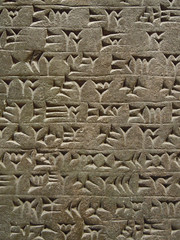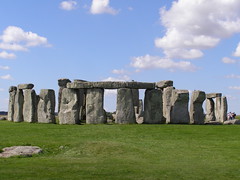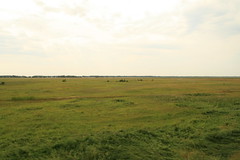From Hunting and Gathering to Civilizations, 2.5 million-1000 B.C.E.: Origins
| 7536484266 | Hunting and Gathering/ Foraging | Means of obtaining subsistence by humans before the mastery of sedentary agriculture; normally typical of tribal social organization |  | 0 |
| 7536484267 | Civilization | Societies with reliance on sedentary agriculture, ability to produce food surpluses, and existence of nonfarming elites, along with merchant and manufacturing groups |  | 1 |
| 7536484268 | Neolithic | The New Stone Age between 8000 and 5000 B.C.E.; period in which adaptation of sedentary agriculture occurred; domestication of plants and animals accomplished |  | 2 |
| 7536484269 | Nomads | Cattle- and sheep-herding societies normally found on the fringes of civilized societies; commonly referred to as "barbarian" by civilized societies |  | 3 |
| 7536484270 | Culture | Combination of ideas, objects, and patterns of behavior that result from human social interaction |  | 4 |
| 7536484271 | Neolithic (Agrarian) revolution | Occurred between 8000 and 5000 B.C.E.; transition from hunting and gathering to sedentary agriculture |  | 5 |
| 7536484272 | Pastoralism | A nomadic agricultural lifestyle based on herding domesticated animals; tended to produce independent people capable of challenging sedentary agricultural societies |  | 6 |
| 7536484273 | Catal Huyuk | Early urban culture based on sedentary agriculture; located in modern southern Turkey; larger in population than Jericho, had greater degree of social stratification |  | 7 |
| 7536484274 | Bronze Age | From 4000 to 3000 B.C.E.; increased use of plow, metalworking; development of wheeled vehicles, writing |  | 8 |
| 7536484275 | Mesopotamia | Literally "between the rivers"; the civilization that arose in the alluvial plain of the Tigris-Euphrates river valleys |  | 9 |
| 7536484276 | Potter's wheel | A technological advance in pottery making; invented circa 6000 B.C.E.; encouraged faster and higher-quality ceramic pottery products |  | 10 |
| 7536484277 | Sumerians | People of Mesopotamia circa 4000 B.C.E.; created the first civilization within the region; organized area into city-states; wheel, base 6 number system |  | 11 |
| 7536484278 | Cuneiform | A form of writing developed by the Sumerians using a wedge-shaped stylus and clay tablets |  | 12 |
| 7536484279 | City-state | A form of political organization typical of Mesopotamian civilization; consisted of agricultural hinterlands ruled by an urban-based king |  | 13 |
| 7536484280 | Ziggurats | Massive towers usually associated with Mesopotamian temple connections |  | 14 |
| 7536484281 | Babylonian Empire | Unified all of Mesopotamia circa 1800 B.C.E.; collapsed due to foreign invasion circa 1600 B.C.E. |  | 15 |
| 7536484282 | Hammurabi | The most important Babylonian ruler; responsible for codification of the law |  | 16 |
| 7536484283 | Pharaoh | The term used to denote the kings of ancient Egypt; the term, "great house" refers to the palace of the pharaohs |  | 17 |
| 7536484284 | Pyramids | Monumental architecture typical of Old Kingdom Egypt; used as burial sites for pharaohs |  | 18 |
| 7536484285 | Hieroglyphs | Form of writing developed in ancient Egypt; more pictorial than Mesopotamian cuneiform |  | 19 |
| 7536484286 | Kush | African state that developed along the upper reaches of the Nile circa 1000 B.C.E.; conquered Egypt and ruled it for several centuries | 20 | |
| 7536484287 | Monotheism | The exclusive worship of one god; introduced by Jews into Middle Eastern civilization |  | 21 |
| 7536484288 | Phoenicians | Seafaring civilization located on the shores of the eastern Mediterranean; established colonies throughout the Mediterranean |  | 22 |
| 7536484289 | Harappa and Mohenjo Daro | Major urban complexes of Indus Valley (Harappan) civilization; laid out on planned grid pattern |  | 23 |
| 7536484290 | Aryans | Indo-European nomadic, warlike, pastorialists who replaced Harappan civilization |  | 24 |
| 7536484291 | Huanghe (Yellow) River Basin | Site of the development of sedentary agriculture in China |  | 25 |
| 7536484292 | Shang | 1st Chinese dynasty, 1700 to 1027 B.C. The first family of Chinese rulers to leave written records. Known for Bronze work. |  | 26 |
| 7536484293 | Oracle Bones (Dragon Bones) | Shamans or priests in Chinese society who foretold the future through interpreting animal bones cracked by heat; inscriptions on bones led to Chinese writing |  | 27 |
| 7536484294 | Ideographic writing | Pictograph characters grouped together to create new concepts; typical of Chinese writing | 28 | |
| 7536484295 | Big Geography | A term that draws attention to the global nature of world history. |  | 29 |
| 7536484296 | Paleolithic | The period that ended about 3,000 years after the end of the last Ice Age, it lasted until about 10,000 years ago. (Old Stone Age) The period of the Stone Age associated with the evolution of humans. It predates the Neolithic period. |  | 30 |
| 7536484297 | Path of migration for humans during Paleolithic era | From Africa to Eurasia, Australia, and the Americas | 31 | |
| 7536484298 | Eglitarian | Believing in the equality of all peoples | 32 | |
| 7536484299 | Humans developed a wider range of ____ specially adapted to different environments from tropics to tundra | tools | 33 | |
| 7536484301 | Patriarchy | Father based. Male dominated |  | 34 |
| 7536484302 | Permanent agricultural villages emerged first in the lands of the eastern Mediterranean, possibly as a response to what? | climatic change | 35 | |
| 7536484303 | Pastoralists were often the developers and disseminators of of ____ and ___ that transformed warfare in agrarian civilizations | new weapons modes of transportation | 36 | |
| 7536484304 | name one mode of new transportation by the pastoralists | Chariots Horseback riding | 37 | |
| 7536484305 | Elites, both political and religious, promoted ____ and ____ | arts artisanship | 38 | |
| 7536484306 | ____ arose independently arose independently in all early civilization and subsequently were diffused | systems of record keeping | 39 | |
| 7536484307 | _____ developed in this period continued to have strong influences in later periods | New religious beliefs | 40 | |
| 7536484308 | Chavin | a culture that thrived in the Andean region (Peru) from about 900 BCE to 200 BCE. |  | 41 |
| 7536484309 | Olmec | they developed the earliest known civilization in Mesoamerica. from about 1500 BCE to 400 BCE |  | 42 |
| 7536484310 | Quipu | knotted cords of various lengths and colors used by the Inca to keep financial records |  | 43 |
| 7536484312 | Zhou | 1046-221 BCE, the longest lasting Chinese Dynasty, developed Mandate of Heaven, as a justification to overthrow the Shang. |  | 44 |
| 7536484313 | Gilgamesh | 2700 BC Sumerian king, mythologized in the Epic of Gilgamesh, often regarded as the earliest surviving great work of literature |  | 45 |
| 7536628432 | Cultural Hearths | a center where cultures developed and from which ideas and traditions spread outward |  | 46 |
| 7536712707 | bipedalism | the ability to walk upright on two legs |  | 47 |
| 7536722909 | hominid | Human like being |  | 48 |
| 7536740144 | megaliths | Large monuments created from huge stone slabs are called: |  | 49 |
| 7536751574 | Stone Age | the period of time when humans relied primarily on stone tools |  | 50 |
| 7536762183 | Paleolithic | Old stone age |  | 51 |
| 7536772089 | Homo sapiens | (wise man) first to create many tools; cave art |  | 52 |
| 7536794290 | scribe | a person who writes things down |  | 53 |
| 7536810217 | papyrus | a reed plant that grew wild along the Nile Egyptian paper |  | 54 |
| 7539171221 | Semitic | Family of related languages long spoken across parts of western Asia and northern Africa. In antiquity these languages included Hebrew, Aramaic, and Phoenician. The most widespread modern member of the Semitic family is Arabic. | 55 | |
| 7539187293 | Memphis | The capital of Old Kingdom Egypt, near the head of the Nile Delta. Early rulers were interred in the nearby pyramids. |  | 56 |
| 7539199845 | ma'at | Egyptian term for the concept of divinely created and maintained order in the universe. The divine ruler was the earthly guarantor of this order |  | 57 |
| 7539235075 | Phoenicians | Semitic-speaking Canaanites living on the coast of modern Lebanon and Syria in the first millennium B.C.E. From major cities such as Tyre and Sidon, Phoenician merchants and sailors explored the Mediterranean, engaged in widespread commerce, and founded Carthage and other colonies in the western Mediterranean. |  | 58 |
| 7539248919 | monotheism | The belief in and worship of only one God |  | 59 |
| 7539258113 | Minoan | Prosperous civilization on the Aegean island of Crete in the second millennium B.C.E. The Minoans engaged in far-flung commerce around the Mediterranean and exerted powerful cultural influences on the early Greeks |  | 60 |
| 7539273343 | Mycenae | Site of a fortified palace complex in southern Greece that controlled a Late Bronze Age kingdom. In Homer's epic poems, Mycenae was the base of King Agamemnon, who commanded the Greeks besieging Troy. Mycenaean |  | 61 |
| 7539298853 | Hittites | A people from central Anatolia who established an empire in Anatolia and Syria in the Late Bronze Age. With wealth from the trade in metals and military power based on chariot forces, the Hittites vied with New Kingdom Egypt for control of Syria-Palestine before falling to unidentified attackers ca. 1200 B.C.E |  | 62 |
| 7539316111 | diaspora | Greek word meaning dispersal, used to describe the communities of a given ethnic group living outside their homeland. Jews, for example, spread from Israel to western Asia and Mediterranean lands in antiquity and today can be found throughout the world | 63 | |
| 7539330737 | Celts | Peoples sharing common linguistic and cultural features that originated in central Europe in the first half of the first millennium B.C.E |  | 64 |
| 7539342695 | Druids | The class of religious experts who conducted rituals and preserved sacred lore among some ancient Celtic peoples. |  | 65 |
| 7539352351 | loess | A fine, light silt deposited by wind and water. It constitutes the fertile soil of the Yellow River Valley in northern China |  | 66 |
| 7539365775 | Mandate of Heaven | Chinese religious and political ideology developed by the Zhou, according to which it was the prerogative of Heaven, the chief deity, to grant power to the ruler of China and to take away that power if the ruler failed to conduct himself justly and in the best interests of his subjects |  | 67 |
| 7539359156 | Kush | An Egyptian name for Nubia, the region alongside the Nile River south of Egypt, where an indigenous kingdom with its own distinctive institutions and cultural traditions arose beginning in the early second millennium B.C.E. |  | 68 |
| 7539382086 | Meroë | Capital of a flourishing kingdom in southern Nubia from the fourth century B.C.E. to the fourth century C.E. In this period Nubian culture shows more independence from Egypt and the influence of sub-Saharan Africa |  | 69 |
| 7539396885 | Steppe | An ecological region of grass- and shrub-covered plains that is treeless and too arid for agriculture |  | 70 |
| 7539430627 | Scythians | Term used by the ancient Greeks for the nomadic peoples living on the steppe north of the Black and Caspian Seas |  | 71 |
| 7539458253 | Sima Qian | Chief astrologer for the Han dynasty emperor Wu. He composed a monumental history of China from its legendary origins to his own time and is regarded as the Chinese father of history |  | 72 |
| 7539481828 | Herodotus | Heir to the technique of historia developed by Greeks in the late archaic period. He came from a Greek community in Anatolia and traveled extensively, collecting information in western Asia and the Mediterranean lands. He traced the antecedents and chronicled the wars between the Greek city-states and the Persian Empire, thus originating the Western tradition of historical writing |  | 73 |
| 7544988960 | Collective learning | One thing that makes us intellectually human; the ability to learn without experiencing something; knowledge can be passed on generation to generation and from stranger to stranger. |  | 74 |
| 7545004725 | Symbolic language | One thing that makes us intellectually human; the ability to use symbols that we can understand as abstract ideas. |  | 75 |
| 7545012944 | Cultural diffusion | The spread of ideas, customs, and technologies from one people to another |  | 76 |

